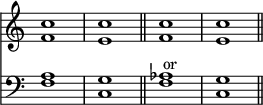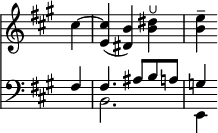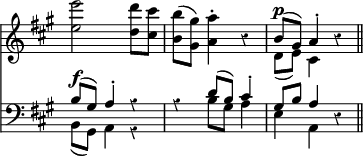A Dictionary of Music and Musicians/Cadence
CADENCE. Cadences or (as they are often called) Closes, are the devices which in music answer the purpose of stops in language. The effect is produced by the particular manner in which certain chords succeed one another, the order being generally such as to produce suspense or expectation first, and then to gratify it by a chord which is more satisfying to the ear. They are commonly divided into three kinds—the Perfect cadence, the Imperfect cadence, and the Interrupted cadence. Some writers specify a greater number, but this only tends to confusion and misconception. All that is requisite is to group the various kinds under names which mark their common effect. Thus every cadence which can be used satisfactorily to end a movement must of necessity be a Perfect cadence. Every cadence which is broken away from at the very moment when it seemed to promise a conclusion is obviously an Interrupted cadence; and every cadence which without producing the effect of interruption leaves the mind unsatisfied and expecting something more should be called an Imperfect cadence. And this classification seems to include all the varieties. Every composer in writing feels that certain cadences are fitted for particular places in his work, and endeavours to give variety in his treatment of them. But it is unwise to give all these possible varieties definite titles, as what may answer the purpose of a full stop in one movement may only produce the effect of a semicolon in another, according to the calibre of the work.
The ideas at the root of the perfect cadence are two: first, that the key be emphatically defined; and secondly, that the expectation roused by the doubtful or discordant nature of one chord be absolutely satisfied by another.
The simplest and most perfect manner of obtaining these effects is the progression from dominant to tonic harmony, as in the example, which is the type of all perfect cadences.

Here the key is strongly marked by the number of notes proper to it which are employed, and also, as Helmholtz has pointed out, 'by the distinct passage from the remotest parts of the scale to the centre of the system' of the key, since the dominant chord contains the notes which are most remote in their relation to the tonic. On the other hand, the tonic chord in its first position is the only chord sufficiently decisive to be used as conclusion; and the dominant harmony must in any case be doubtful and inconclusive, even when concordant, and the effect is enhanced when, as in the example, a discord is made use of.
The common use of the major third in the tonic chord in the final cadences of pieces in a minor key is for the purpose above mentioned, of marking the key strongly, as the minor third is more obscure in character than the major third, and without the latter, especially in vocal music, the conclusion would not be so clear and incisive.
In old times, especially in church music, another very simple form of cadence was common; viz. that in which the penultimate chord is that of the sub-dominant or 4th of the key, either major or minor, as, in the key of C—

These two forms of the perfect cadence were distinguished as the Authentic and the Plagal, from the two main divisions of the ancient church modes. The latter is not so frequently used in modern music, except sometimes for variety, or to follow some particular turn of romance or sentiment which is expressed in the music.
The commonest form of Imperfect cadence is just a reversal of the dominant perfect cadence, so that the harmony of the dominant or 5th of the key is preceded by that of the tonic. In this case the effect will evidently not be conclusively satisfying, because a piece can only come to a complete stop on the harmony of the tonic. So, in the key of C, the cadence—

will leave the mind unsatisfied, though to a certain extent it produces the effect of a stop.
Another common form of imperfect cadence is that in which the harmony of the dominant is preceded by that of the supertonic, or 2nd note of the scale, direct or in inversion, thus—

as in Mozart's Quartet in G, No. 1—

and in Beethoven's Violin Sonata in G—

or the following from his Symphony in C minor—
![{ \override Score.TimeSignature #'stencil = ##f \override Score.Rest #'style = #'classical \time 2/4 \key c \minor << \relative g'' { r8 <g d g,>[ <g d g,> <f d g,>] | <ees c g>4 r | <c fis> r | << { g'2 } \\ { <b, g>4 r } >> | }
\new Staff { \clef bass \key c \minor \relative b, { r8 b[ b b] | c4 r | aes r | g r | } } >> }](http://upload.wikimedia.org/score/r/m/rmav0j0v6yx4w99ixc8nbtlx6i5ve22/rmav0j0v.png)
When a complete strain or subject is divided into two parts the first half frequently ends with an imperfect cadence, by which the continuity of the passage is not affected, though the division is sufficiently marked.
The imperfect cadence is also sometimes called a half close, which term has a good deal to recommend it as the fitter name of the two, both from its form and from the position it frequently occupies, as mentioned above.
The form of Interrupted cadence generally quoted as typical is that in which the chord of the dominant, instead of proceeding to the harmony of the tonic as the mind is led to expect, is followed by the chord of the 6th of the key, or sub-mediant, thus—

But in point of fact this gives but a very small notion of what an interrupted cadence really is. For it can only be distinguished from an imperfect cadence with certainty by reference to the context. The latter is a definite stop occurring in the natural course of the music, and marking a period, though not in such a way as to enable the passage which it ends to be taken as complete in itself. But the former is an abrupt and irregular interruption of the natural flow of the music towards its anticipated termination in a perfect cadence, postponing that termination for a time or altogether avoiding it. Thus at the end of the first movement of the Sonata in C, op. 53, Beethoven keeps on postponing the perfect cadence in this manner—

In his later works an entire evasion of the cadence is frequent, as in the first movement of the Sonata in E, op. 109—
![{ \override Score.TimeSignature #'break-visibility = #'#(#f #t #f) \time 2/4 \key e \major \partial 4 << { << \relative g' { b4 | fis' cis16 ais'8. } \\ \relative g' { gis16 gis'8. | fis16 <dis b>8. ais4 } >> \bar "||" \time 3/4 \tempo "Adagio" \set tieWaitForNote = ##t \relative a' { \grace { a32[ ~ bis ~ dis ~ fis] ~ } <a, bis dis fis a>4 ~ <a bis dis fis a>8 gis'16-. fis-. <e cis> } }
\new Staff { \clef bass \key e \major \relative e { r8 e16 e' | r8 fis16 fis, r8 fis,16 fis' | r8 << { <bis dis>16-.( e-.) \clef treble fis gis a8 gis16 } \\ { <fis, a>8 \clef treble r8 <bis dis> <cis e>16 } >> } } >> }](http://upload.wikimedia.org/score/p/y/pywh795dlfk0ne2tha9o9e93phmnapw/pywh795d.png)
It is a common practice with writers of treatises on harmony to give a series of chords preparatory to the two final ones which are given above as the perfect cadence. This makes it look as though the treatises were meant to teach people to make music at so much a yard; for a man who really has something to say in music which he feels naturally is only hampered and worried with every extra direction of the kind, which tells him to put in so much that cannot possibly mean anything because it is everybody's property. A real musician only requires directions and general principles, which are capable of considerable expansion according to the power of his genius. The rule seems simply to be that, relative to the degree in which the cadence is final, the passage which immediately precedes it must mark the key in which it is made. The sense of the key in which any movement is written is of extreme importance for the comprehension of the music, especially in instrumental music, and such as depends much upon its form of construction. Hence a cadence of any finality must mark the key strongly. Subordinate cadences, such as occur in the course of the movement, especially apart from the broader divisions of the movement, need not be so marked; but if the final cadence of the whole movement, or that of an important subdivision of a movement, is simply a couple of chords or so immediately succeeding a passage in a foreign key, the sense of whereabouts is lost, and an entirely unsatisfactory effect produced by the indecisiveness of the conclusion.
The tendency of modern music has been to avoid full cadences in the course of a piece of music, and when they become necessary to vary them as much as possible. The former, because frequent cadences make a movement into a fragmentary series of continually recommencing passages, coming each time to a full stop and beginning again; the latter, because the mind has become so habituated to the form of the ordinary perfect cadence that in a movement of highly emotional character it comes rather like a platitude. Besides, though form is a great and often the principal element of beauty in a movement, to make it too obvious by the marked nature of the cadences destroys the interest and freshness of the work. Mozart marked the divisions of his movements very strongly, but in his day the forms of instrumental music were not by any means so familiar as they are now, and their being strongly marked was necessary for their due comprehension. Besides, in Mozart's day people had much more time to sit down and rest between one action and another than they seem to have now, and perfect cadences are exactly like sitting down and resting when one tune is over so as to be fresh for the next when it makes its appearance. And the analogy goes even further, for the movement in which one sits down least often and least completely is that which is most like one great action with a single principle at its basis rather than a series of somewhat disconnected motions, which are chiefly recommended by their mutual contrasts and relative proportions.
With regard to the position of the chords in the bar, the commonest position is that in which the final chord is on the first beat of the bar, or the strongest beat of all when the bars are thrown into groups by the rapidity of the time of the movement. So that the cadence proceeds from a chord without emphasis to a chord with it, or in other words, from the unaccented to the accented part of the bar; as first—

from Mozart's Quartet in A, No. 5; or—

from his Quartet in E♭, No. 4.
The next commonest position is to find the final chord in the middle of a bar which is equally divisible into two halves, as on the third beat of a bar of four, and the fourth of a bar of six. Of both of these Mozart makes very frequent use—as in the first movement of the first Quartet, the slow movement of the Quartet in B♭, the Rondo for pianoforte in A, and the Variations in the Sonata in A. Very often he seems to use this position with a sense of its being weaker and less conclusive than that in which the last chord falls on the first beat of a bar, and hence as a kind of pseudo-imperfect cadence; as in the slow movement of the Quartet in D minor, No. 2, which begins thus—

Cadences are also, but far more rarely, found occupying reversed positions, as in polonaises, where the last chord of a cadence, owing to the peculiar rhythmic character of the movement, frequently falls on the last beat of a bar of three; as in Chopin's Polonaise in C♯ minor—
![{ \override Score.TimeSignature #'stencil = ##f \time 6/8 \key des \major << << \relative a' { aes16[ r32 a bes16 c] ees4 des8 r } \\ \relative g' { <ges c,>8 s r <aes ges> f } >>
\new Staff { \clef bass \key des \major \relative a,, { aes8 <aes'' ees'> r <aes c> <des des,> r } } >> }](http://upload.wikimedia.org/score/b/k/bk6700p6iyn59t8n1rvfjoc8ffpq6ot/bk6700p6.png)
In Mozart's Rondeau en Polonaise, from the Sonata in D, the cadences fall on the second beat, as in
![{ \override Score.TimeSignature #'stencil = ##f \key a \major \override Score.Rest #'style = #'classical \time 3/4 << \relative a' { a16\p b\cresc cis d e fis gis a gis fis e d | cis\f e d b << { <b d,>4 <a cis,> \bar "||" } \\ { e2 } >> }
\new Staff { \clef bass \key a \major \relative a { r4 <a e cis> <a d,> | << { a8[ gis] } \\ { e4 } >> a8 e a,4 } } >> }](http://upload.wikimedia.org/score/r/5/r53kxethvh4sc2lg6sv794rahvydry2/r53kxeth.png)
where the B and D are merely suspensions of the final chord of A—and in Beethoven's Quartet in A minor, op. 132, the last chord of the cadences in the movement 'Allegro ma non tanto,' falls on the second beat of a bar of three—

and in the slow movement of his Quartet in B♭, op. 130, at the end, the last chord falls on the last beat of a bar of four—
![{ \override Score.TimeSignature #'stencil = ##f \time 4/4 \key des \major << \relative c''' { << { c8[ des] aes[ bes] aes,16[ r c] } \\ { ges8:32[ f8:32] ees32[ ees des des] des[ des <ees des> <ees des>] <f des>16[ r g] } >> r16\fermata \grace { aes,16[( <des f> aes')] } <f des'>8 r \bar "||" }
\new Staff { \clef bass \key des \major \relative e { << { ees8:32[ des8:32] s4. ees16 s des8 r } \\ { aes8:32[ bes8:32] <c ees>32[ <c ees> <des f> <des f>] <ees g,>[ <ees g,> g, g] aes16[ r aes] r_\fermata \grace { des,16[ aes' f'] } des,8 } >> } } >> }](http://upload.wikimedia.org/score/l/5/l59a8qpmwvoyk2grkenh4g0n7bv70sb/l59a8qpm.png)
[ C. H. H. P. ]
